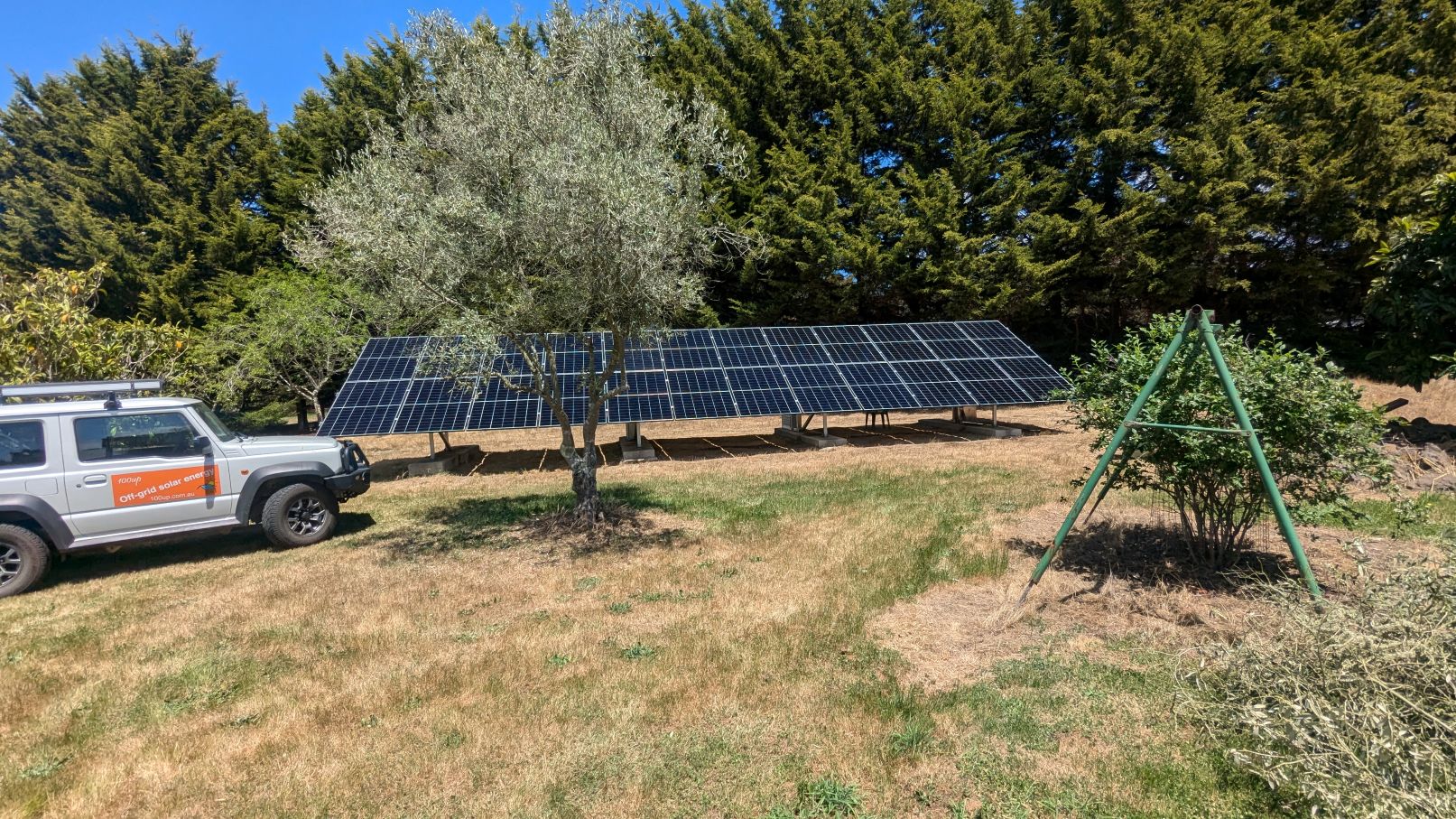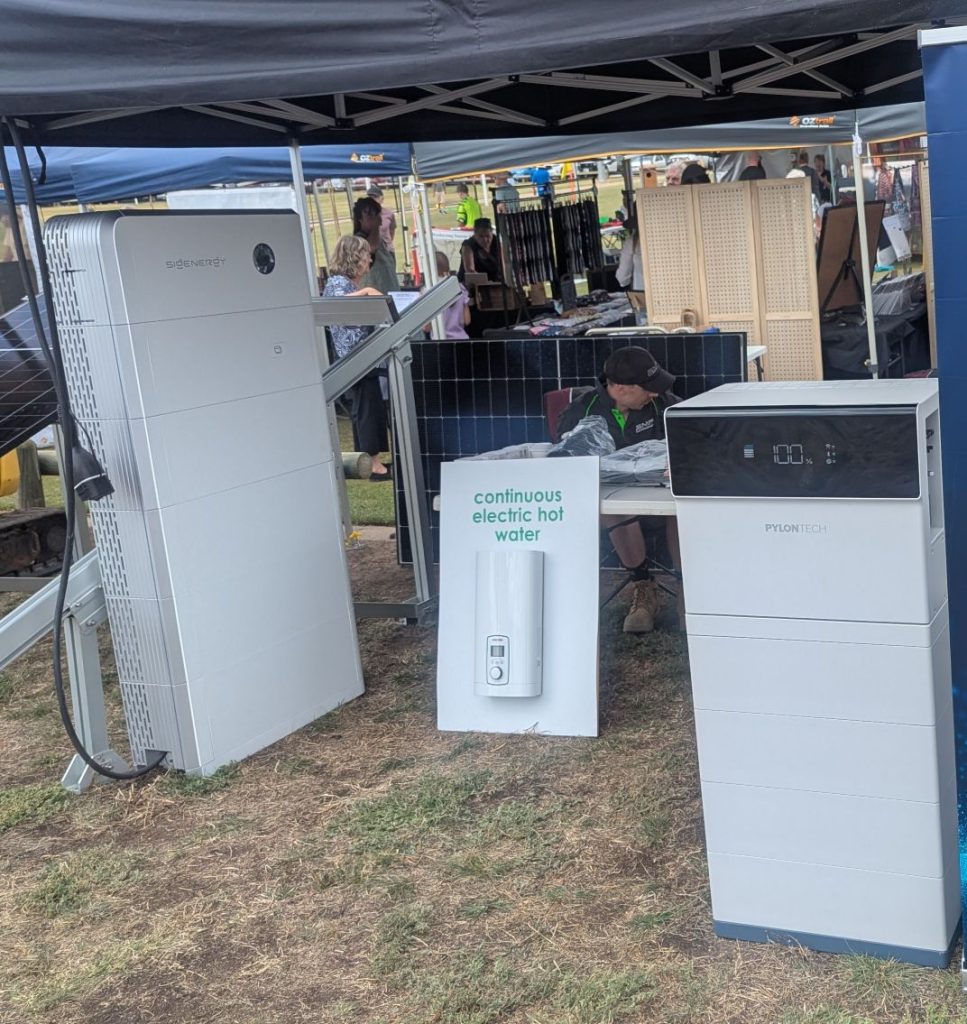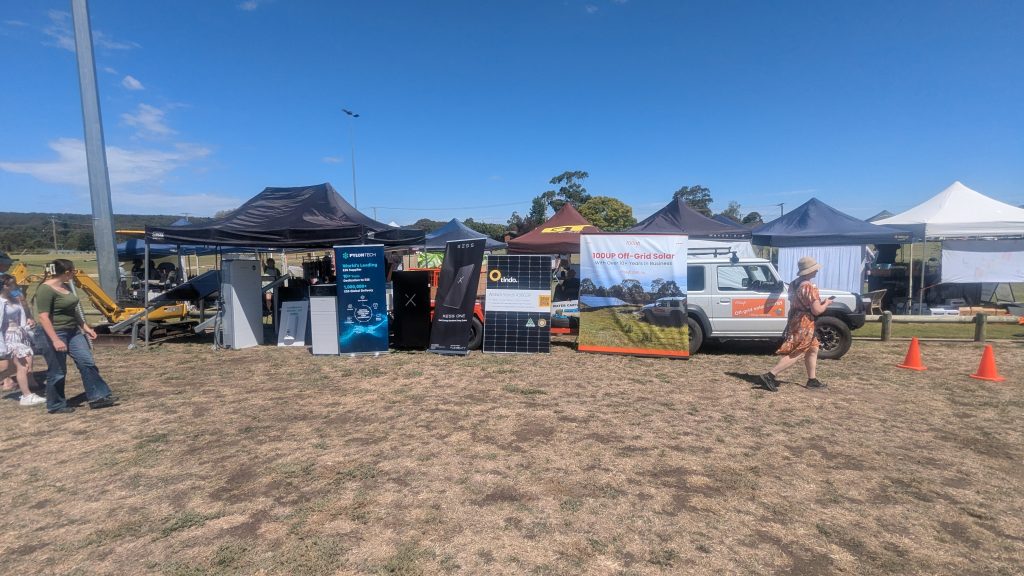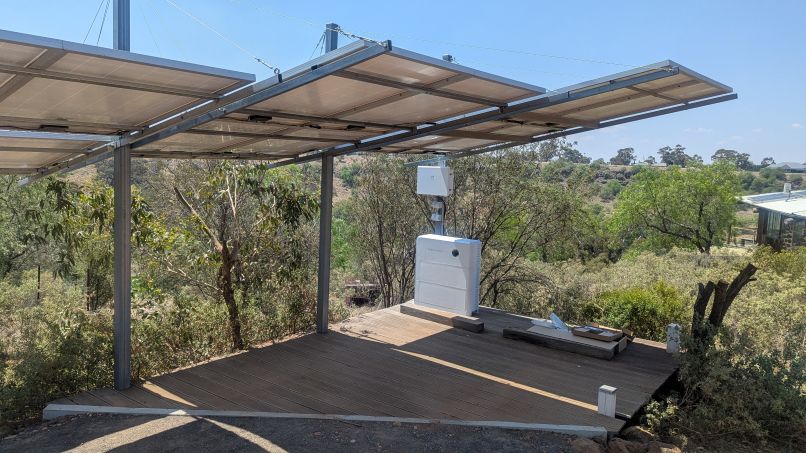
Ballarat presents a challenge for off-grid solar power supply, especially in winter when avoiding generator use is desired. While it’s tough, it’s achievable with the right approach. Leveraging solar STC rebates and utilizing equipment like the Sigenergy inverter, which supports double the capacity of solar panels relative to inverter size, we’ve tailored solutions to meet these needs. We offer three system configurations using this model: 12 kW, 24 kW, and 36 kW. This setup involves pairing a 6 kW inverter with 12 kW of panels, and by paralleling 6 kW inverters, we can create systems of 24 kW and 36 kW. Each inverter requires two 8 kWh batteries to provide adequate power. Learn more about our system configurations here.
Smarter Off-Grid Solar Systems for Ballarat & Regional Victoria
Modular. Redundant. Designed for energy independence.
At 100UP, we design and install off-grid solar systems for homes, farms, sheds, and rural properties across Ballarat and surrounding regions. Whether you’re building from scratch or upgrading an existing setup, we deliver practical, scalable solar systems that are designed to perform in real Australian conditions.
Our latest system range is built around the Sigenergy all-in-one platform – combining inverters, lithium battery storage, and smart monitoring in a fully integrated setup.
Why We Use Parallel Inverters in Larger Systems
For our larger systems – the 100UP 12–16 Off-Grid and 100UP 16–32 Off-Grid – we use two inverters in parallel as standard. This isn’t just about more power — it’s about smarter system architecture and long-term reliability.
Most dual-inverter systems on the market still rely on one master inverter. If that unit fails, the entire system can shut down until it’s reprogrammed or replaced.
With Sigenergy, each inverter runs independently. That means:
- If one inverter fails, the other keeps your home or farm powered
- No system-wide shutdown
- No urgent reprogramming or technician required
- Critical loads stay online, even during faults or servicing
This kind of built-in redundancy is a major advantage for off-grid homes where reliability matters.
Weatherproof and Flexible – IP65 Rated for Outdoor Mounting
Sigenergy inverters and battery modules are IP65 rated, which means they’re fully weatherproof and safe to install outdoors — even without an enclosure.
This is particularly useful for systems with ground-mounted solar panels, where the inverter and battery can be installed directly behind the solar array. It saves space, reduces cabling costs, and makes the whole install neater and more accessible.
Optional: Use Your EV as Backup Storage
Our systems are also compatible with DC bidirectional EV chargers, such as Sigenergy’s EVLink.
With this setup, your electric vehicle becomes a mobile battery that can:
- Charge directly from solar
- Discharge power back into your home when needed
- Provide 50–80kWh of additional storage during cloudy periods or winter
It’s a powerful way to extend your off-grid capacity without adding more batteries — especially helpful in winter.
Take Advantage of the New Battery Rebate – Think Long Term
With new and expanded battery rebates becoming available in Victoria, we strongly encourage off-grid customers to consider investing in additional storage.
If you already have a fixed system budget, this is a great opportunity to:
- Increase your battery bank rather than reduce the system cost
- Improve performance during winter and cloudy stretches
- Reduce future costs by avoiding upgrades or retrofits later
We can help you size your system to take full advantage of available rebates and support your long-term energy needs.
Choose the Right System for Your Property
| System Name | Inverter Capacity | Battery Storage | Solar Capacity | Installed Cost (after rebate) |
|---|---|---|---|---|
| 100UP 5–8 Off-Grid | 5kW | 8kWh | 3–10kW | $16,000–$22,000 |
| 100UP 12–16 Off-Grid | 2 × 6kW (12kW total) | 16kWh | 8–20kW | $32,000–$42,000 |
| 100UP 16–32 Off-Grid | 2 × 8kW (16kW total) | 32kWh | 12–30kW | $45,000–$60,000 |
All pricing is indicative. Final quote provided after site inspection and rebate eligibility check.
Locally Installed and Professionally Supported
Based just outside of Ballarat, the 100UP team understands the challenges of living off-grid in regional Victoria — from power-hungry winters and generator planning to bushfire safety and long-term reliability.
We design every system with the region’s conditions in mind — and back it with honest advice and local support.
Ready to Talk?
Whether you’re planning a new off-grid build or looking to upgrade an existing system, we’re happy to help.
📱 Call or text: 0400 092 621
Latest Off-Grid Solar Equipment Used in Europe (2023–2025): A Guide for Ballarat Locals

f you’re living around Ballarat and thinking about off-grid solar, it’s smart to check out what gear people are using in Europe right now. These systems are being tested year-round in cold, cloudy places and are proving reliable—exactly what we need here in Victoria. Here’s a quick rundown of the latest inverter and battery brands making an impact across Europe from 2023 to 2025.
Sigenergy (China)
- Product: SigenStor – a 5-in-1 unit (inverter, battery, EV charger, BMS, EMS)
- Highlights: Scalable, good for homes and small businesses
- Why Europe Likes It: Clean all-in-one design, fast off-grid switchover, smart controls
Deye (China, sold as Sunsynk in Australia)
- Product: Hybrid/off-grid inverters (3.6kW–20kW)
- Highlights: Weatherproof, can run totally off-grid, handles big loads with parallel units
- Why It’s Popular: Good value, solid performance in rural setups
Pylontech (China)
- Product: Modular lithium batteries – US series and Force range
- Highlights: 6000–8000+ cycles, widely compatible, stackable
- Common Use: Often paired with Victron, Deye, and other off-grid inverters
Victron Energy (Netherlands)
- Product: MultiPlus-II and Quattro inverter/chargers
- Highlights: Super flexible, works well off-grid or in hybrid mode
- Where It’s Used: European cabins, mobile setups, and farm properties
Growatt (China)
- Product: SPH, MOD, WIT inverters with APX battery systems
- Highlights: Residential and commercial use, built-in UPS function
- Why Europe Uses It: Easy to install, decent pricing, supports full off-grid use
BYD (China)
- Product: Battery-Box Premium (LV and HV options)
- Highlights: Reliable in cold climates, long-lasting, works with most major inverters
- Off-Grid Use: Found in homes and small business systems across Europe
Ballarat locals can take confidence from these European setups. They’re already working in similar climates and off-grid conditions—just like we see here in winter. Many of these brands are now available in Australia and fit well into local off-grid solar systems.
Hi Ballarat – Check Out This New Off-Grid Solar Combo!

Looking for a powerful, reliable, and cost-effective off-grid setup? You’re going to love this.
The latest system combo pairs the new Jinko 500W panels with the Sigenergy 8kW and 10kW single-phase inverters, giving you serious performance. With these inverters now supporting up to 16kW and 20kW of solar respectively, you can run more of your home or property off the sun—no worries.
Thanks to the high-efficiency Jinko 500W panels, you’ll need far less roof space to hit your energy goals. Each panel still measures a compact 1.9m x 1.13m, but now packs way more punch. That’s a big win, especially for homes with limited roof space.
Why These Panels Stand Out:
Up to 510W per panel
N-Type TOPCon cell tech for better low-light and overall performance
Only 0.4% annual power loss after year one
30-year performance warranty
Weather tough – handles up to 5400 Pa of front load and 2400 Pa at the rear
Over 23.5% module efficiency – that’s premium-tier output
These panels are perfect for off-grid systems in Ballarat, whether you’re building a new setup or upgrading. Designed to perform in Aussie conditions, built to last decades, and now more space-efficient than ever.
Want help sizing up a system or working out your winter energy needs? Just shout!

Ballarat Sustainability Show Wrap-Up: Off-Grid Solar & Exciting Innovations
Hello Ballarat! We participated in a fantastic sustainability show in Baninyoung this Sunday, where there was a lot of interest in solar and battery systems. As usual, we focused on off-grid solar solutions and products suited for these applications.
We presented Australian-made off-grid solar equipment from XESS—a fantastic and highly flexible solution. We also showcased the Sigenergy system, which features DC car charging capabilities, and Pylontech’s all-in-one H# inverter and battery systems. Additionally, we had Australian-made solar panels from Tindo and highly shade-resistant Aiko solar panels on display.
There was also a lot of interest in ground-mounted solar panel systems, highlighting the demand for flexible installation options.
Off-Grid Solar Systems in Ballarat – Is It Worth It?
Thinking about cutting ties with the grid? You’re not alone. Plenty of people in Ballarat are ditching power companies and switching to off-grid solar. Whether it’s to save money, avoid blackouts, or just live more sustainably, having your own independent power system makes a lot of sense.
What Does an Off-Grid System Actually Include?
If you’re going off-grid, your home won’t be connected to the main electricity network at all. That means you’ll need a system that can generate, store, and manage all your power. A proper off-grid setup includes:
- Solar panels – To generate electricity during the day.
- Batteries – To store extra power for nights and cloudy days.
- An inverter – Converts stored power into usable electricity for your home.
- A backup generator (optional) – For long stretches of bad weather.
Because Ballarat has some pretty gloomy winters, an off-grid system here needs more battery storage and solar panels compared to sunnier parts of Australia. The goal is to make sure you always have enough power, even in the middle of winter.
Why Go Off-Grid in Ballarat?
- No more power bills – Once your system is installed, your electricity is free.
- No more blackouts – When the grid goes down, you won’t even notice.
- Total energy independence – No relying on power companies.
- Perfect for rural properties – No expensive connection fees.
How Big of a System Do You Need?
It depends on your energy use, but most off-grid homes in Ballarat need:
✔ 10-15kW of solar panels – To generate enough power year-round.
✔ 20-40kWh of battery storage – To last through the night and bad weather.
✔ A 10-15kW inverter – So you can run multiple appliances at once.
Every home is different, but Ballarat’s winter sun is a big factor when designing a system. We make sure there’s enough solar and battery backup to keep you running smoothly all year.
Real Off-Grid Setups for Real Homes
We’ve set up off-grid systems all over Ballarat – from small weekend cabins to full-sized family homes. Some people just want basic power for lights and a fridge, while others need enough energy to run a whole household with heating, appliances, and electric vehicles.
If you’re serious about going off-grid, get in touch and we’ll help you figure out exactly what you need.
Off-Grid Solar EV Charging Station Near Ballarat

Hey Ballarat!
Here’s a small but interesting project—an absolutely off-grid solar setup designed to charge a golf cart or electric car. It’s a freestanding system with 3kW of solar panels, a 6kW Senergy inverter, and a 16kWh battery bank. Charging is done simply through 15A and 10A power points.
This property isn’t far from Ballarat, and the house itself has a separate off-grid solar system. Pretty cool setup!
Recent installation of Off grid solar with Sigenergy equipment near Ballarat

System Description: The solar panel array has an 11kW capacity, paired with a 12kW inverter. Energy storage – 26kWh lithium battery bank
Challenges and Solutions for Off-Grid Solar Systems in Ballarat’s Forested Areas
June and July present significant challenges for off-grid solar systems in the Ballarat area, as these months record the lowest solar production of the year. Life in forested locations becomes especially difficult during this period. Many installations are affected by shading, and unfortunately, there is very little that can be done to mitigate this issue. Essentially, some extra expense will have to be incurred for trimming trees, which can be very expensive and not always permitted. Alternatively, using a generator becomes necessary, which involves the unpleasant experience of dealing with fuel and oil.
Many people raise questions about wind turbines as an addition to solar to mitigate these problems. Unfortunately, wind turbines appear not to be a viable solution. The primary reasons are the lack of a proper supply of small wind turbines in Australia and the limited availability worldwide. What is available is prohibitively expensive and offers low productivity. The domestic solar industry has essentially abandoned wind power. I recently attended the largest exhibition for renewable energy in the EU and could find only one supplier from Poland offering a small wind turbine, priced at around $20,000.
Still, an off-grid solar system in the Ballarat area can be built without generator support, but not in forested sites. Anyone living in the bush with trees close to the house will have to include a generator in their system.
Battery Upgrades: Winter Challenges in Off-Grid Solar Systems in Ballarat
Ballarat’s winter weather reveals all the issues in off-grid solar systems. Any weak points in the system, such as an old battery, a small solar panel array, or a malfunctioning generator, become apparent during this time. Battery upgrades or even the replacement of entire systems become our primary work in the Ballarat region starting from June. Some people manage to survive these issues for a while, but by June, everyone has had enough and starts seeking solutions.
Most of the systems are equipped with Selectronic inverters and are around 5-7 years old, with lead-acid batteries nearing the end of their life. We use 48V Pylontech batteries, and typically, we need to add a new board to the inverter and update the software to ensure compatibility and optimal performance.
Usually, systems with 12V and 24V batteries are not upgradeable. We normally replace the entire setup as 24V batteries are not common anymore. Of course, people can say everything can be upgraded, and while that’s true, it is usually not worth the expense.
Hi Ballarat! Let’s Talk About Off-Grid Solar System inverters
Are you planning to go off-grid in Ballarat? It’s a great choice for energy independence, and with so many options on the market, it’s worth knowing which equipment stands out. Let’s dive into the top inverters and see what makes them a good (or not-so-good) choice for your off-grid solar setup.
Off-Grid Inverter Comparison Table
| Feature | Selectronic SP PRO | Victron MultiPlus-II | Sigenergy Sigen Hybrid | Deye Hybrid Inverter | SMA Sunny Island |
|---|---|---|---|---|---|
| Power Range | 3 kW – 20 kW (scalable up to 240 kW) | 3,000 VA – 15,000 VA | 3 kW – 25 kW | Single-phase: 3 kW – 16 kW Three-phase: 8 kW – 12 kW | 3.3 kW – 6 kW (scalable up to 300 kW) |
| Battery Compatibility | 24V, 48V, and 120V Lead-acid and lithium-ion | Lead-acid and lithium-ion | SigenStor BAT modules (up to 6 per controller) | 48V low-voltage systems Lead-acid and lithium-ion | Advanced battery management for extended life |
| MPPT Included | No (requires external MPPT controllers) | No (requires external MPPT controllers) | Yes, up to 4 MPPTs | Yes, built-in MPPT | No (requires external MPPT controllers) |
| Monitoring and Control | Advanced energy management with modular expandability | Remote access and control via Victron’s GX devices | mySigen App for real-time insights and control | Remote monitoring and control via app | WLAN/Ethernet for smartphone/tablet access |
| Scalability | Scalable to 240 kW for large setups | Parallel operation supports scaling for growing needs | Modular design for larger systems | Parallel support for up to 16 units | Parallel systems scalable to 300 kW |
| Efficiency | Optimized for Australian conditions with high durability | Highly efficient with flexible configurations | Up to 4 MPPTs for maximum solar harvesting | High DC/AC ratio and flexible coupling | Advanced energy management for optimized use |
| Applications | Off-grid and hybrid systems Residential, commercial, industrial | Off-grid and grid-connected Small to large applications | Residential and commercial setups EV integration options | Small to large residential Rural properties, cabins | Residential, commercial Remote rural communities |
| Advantages | High surge capacity; designed for Australian conditions; extremely scalable. | Modular and reliable; easy remote monitoring; wide battery compatibility. | Built-in MPPTs; IP66 weatherproof rating; high power range; modular setup. | Integrated MPPT; excellent for unbalanced loads; compact design; easy installation. | Reliable; modular for three-phase setups; excellent battery management. |
| Disadvantages | Requires external MPPT controllers; higher upfront cost. | Requires external MPPT controllers; less user-friendly for DIY installations. | Higher cost; less established in some markets. | Heavier and bulkier; higher cost. | Requires external MPPT controllers; lower continuous power range. |
| User Feedback | Reliable but minor issues with Select.Live monitoring and geckos entering units. | Reliable but complaints about fan noise and rare charging issues. | Positive feedback overall but limited reviews available. | Quiet and robust but few detailed user reports. | Reliable and durable but needs external MPPT and limited reviews. |
| Warranty | 10 years (with Selectronic Certified Installer) | 5 years (extendable to 10 years with registration) | 10 years | 10 years | 5 years |
What’s the Verdict for Ballarat?
The choice of inverter depends on your specific needs. Here’s a quick summary to help you decide:
- Selectronic SP PRO: Ideal for large properties needing scalability. It’s a local favorite with great reliability, but you’ll need an external MPPT controller.
- Victron MultiPlus-II: Perfect for flexible setups and DIY enthusiasts. Remote monitoring is a big plus, but external MPPT controllers are necessary.
- Sigenergy Sigen Hybrid: Great for modern systems with built-in MPPTs. A newer player with positive reviews so far.
- Deye Hybrid Inverter: Reliable and compact for small to medium setups. Works well with unbalanced loads.
- SMA Sunny Island: A trusted choice for durability and battery care. Works best for homes focused on long-term performance.
Whatever you choose, off-grid living in Ballarat is about freedom and sustainability. Make sure to get advice from a local installer to find the perfect system for your property.
Let’s power Ballarat the off-grid way—clean, reliable, and independent!
read more :
Off-Grid Solar And Ballarat Weather
Off-Grid Solar Systems In Ballarat Are Highly Effective
Solar Panels Work On Cloudy Days In Ballarat
Exploring Off-Grid Solar Systems In Ballarat: The Generator Dilemma
Exploring The Benefits Of A 20kW Off-Grid Solar System For Ballarat Homes In Victoria, Australia
20kW Off Grid Solar System Installation Ballarat Victoria
TwinGuard Off-Grid Solar near Ballarat
Expanding Your Solar Horizons in Ballarat: Embrace the Power of Off-Grid Solar
Ballarat, with its unique blend of historical significance and a forward-looking community, presents an ideal backdrop for the adoption of off-grid solar systems. The push towards renewable energy is more than just a trend; it’s a commitment to a sustainable and self-sufficient lifestyle. Here’s why Ballarat residents are turning towards off-grid solar systems:
1. Embracing Energy Independence:
- In Ballarat, the move towards off-grid solar systems is not just about saving on electricity bills; it’s about gaining independence from traditional power grids. This autonomy is especially valuable in areas where grid power is unreliable or expensive.
2. Harnessing Ballarat’s Solar Potential:
- With an average of more than 200 sunny days per year, Ballarat is in a prime position to harness solar energy. Off-grid solar systems capitalize on this natural resource, turning every ray of sunshine into usable power.
3. Sustainable Living and Environmental Stewardship:
- Ballarat’s community, deeply rooted in both history and nature, shows a strong commitment to environmental stewardship. Off-grid solar systems reduce reliance on fossil fuels, contributing to a cleaner, more sustainable future.
4. Tailored Solutions for Every Home:
- Every household in Ballarat is unique, and so are their energy needs. Off-grid solar systems can be customized to match various energy consumptions, ensuring that every home gets the right system for their specific requirements.
5. Financial Incentives and Rebates:
- The local government offers various incentives and rebates for solar installations, making the switch to off-grid solar systems more accessible and affordable for Ballarat residents.
6. Community and Knowledge Sharing:
- The Ballarat community is known for its strong sense of togetherness. This communal spirit extends to the realm of renewable energy, where knowledge and experiences about off-grid living are shared, fostering a supportive environment for newcomers to solar energy.
Conclusion: Ballarat’s journey towards a more sustainable future is well underway, with off-grid solar systems leading the charge. By embracing this renewable energy source, residents are not only contributing to a greener planet but are also paving the way for a more resilient and self-sufficient community. Join the movement and be part of Ballarat’s bright solar-powered future!
Off-Grid Solar Systems Ballarat
Off-grid solar refers to a standalone solar power system that operates independently of the traditional power grid. In other words, it is a self-sufficient battery bank that generates energy source using solar panels and stores it in batteries for later use. An off-grid solar system in Ballarat, Australia, can provide a reliable source of energy in areas without access to the grid or as a backup energy source during power outages. This grid system is becoming increasingly popular as it allows for greater energy independence and cost savings in the long term.
Off-Grid Solar System Installation
An off-grid solar installation typically involves the following steps:
- Site Assessment: A site assessment is conducted to determine the solar energy potential of the location and to determine the size and specifications of the system required.
- System Design: Based on the site assessment, the system design is created. This includes the number and size of solar panels, battery capacity, and other components such as inverters and charge controllers.
- Component Selection: The appropriate components are selected based on the grid solar system design, local regulations, and budget.
- Installation: The components are installed, including mounting the solar panels, connecting the wiring, and setting up the battery
- Commissioning: The system is tested and commissioned to ensure it is working correctly and meets the required specifications.
- Maintenance: Regular maintenance is required to ensure the off-grid system continues to operate at peak performance.
Off-grid solar installations require specialized knowledge and expertise to ensure the solar grid system operates safely and efficiently. It is advisable to engage a professional solar installer to handle the installation.
Off-Grid and Grid Solar Systems Repair
Repair of off-grid and grid-connected solar panels in Ballarat typically involves the following steps:
Troubleshooting: The first step is to diagnose the issue. This may involve checking the grid system’s wiring, connections, and components, as well as monitoring the grid system’s performance and readings.
Parts replacement: If a component is found to be faulty, it may need to be replaced. This may involve replacing a faulty solar panel, battery, or inverter, among other components.
System testing: Once the solar grid repairs have been made, the grid system is tested to ensure it is functioning correctly and meeting the required specifications.
For off-grid and grid-connected systems, it is important to engage a qualified solar repair specialist to carry out the repairs, as the work may involve a high-voltage energy source, which can be dangerous if mishandled. Regular maintenance is also important to ensure the solar grid system and solar panels continue to operate safely and efficiently and to extend their lifespan.
Off-Grid Solar System Upgrade
Investing in a grid solar system upgrade is similar to boosting your energy source independence. Assess the existing system, plan the update (additional panels, larger batteries, etc.), choose new components, install and connect everything, test it all out, and enjoy the enhanced dependability and efficiency of the grid system when it has been upgraded. So, boost your life off the grid system with a solar energy upgrade!



